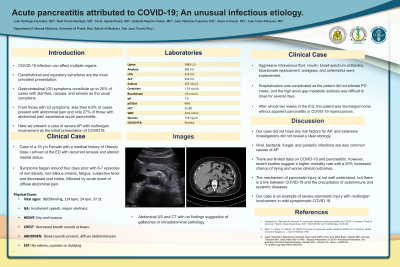Back


Poster Session D - Tuesday Morning
Category: Biliary/Pancreas
D0046 - Acute Pancreatitis Attributed to COVID-19: An Unusual Infectious Etiology
Tuesday, October 25, 2022
10:00 AM – 12:00 PM ET
Location: Crown Ballroom

Has Audio

Juan Carlos C. Santiago-Gonzalez, MD
University of Puerto Rico Medical Sciences Campus
San Juan, Puerto Rico
Presenting Author(s)
Juan C. Santiago-Gonzalez, MD1, Tania Águila, MD2, Noel Torres-Santiago, MD3, Gabriela M. Negron-Ocasio, MD1, Juan G. Feliciano-Figueroa, MD3, Josue Ocasio, MD4, Jose Colon, MD5
1University of Puerto Rico Medical Sciences Campus, San Juan, Puerto Rico; 2University of Puerto Rico School of Medicine Internal Medicine Program, San Juan, Puerto Rico; 3University of Puerto Rico School of Medicine, San Juan, Puerto Rico; 4University of Puerto Rico, Medical Sciences Campus, San Juan, Puerto Rico; 5University of Puerto Rico, Internal Medicine Program, San Juan, Puerto Rico
Introduction: COVID-19 can affect multiple organs and has various presentations, including respiratory symptoms and fever being the most common. Gastrointestinal symptoms can be reported in up to 25% of patients, with diarrhea, nausea, and emesis the usual presentation. However, abdominal pain is less than 6.8% of cases, and of those, only 27% presented with Acute Pancreatitis (AP). Here we present a case of severe AP with multiorgan involvement as the initial presentation of COVID19.
Case Description/Methods: Case of a 19 y/o Female with a medical history of Obesity class I arrived at the ED with recurrent emesis and altered mental status. Symptoms began around four days prior with 6-7 episodes of non-bloody, non-bilious emesis, fatigue, subjective fever, and decreased oral intake, followed by acute onset of diffuse abdominal pain. Upon arrival, the patient was found encephalopathic with dry oral mucosa, tachycardic and tachypneic. Laboratories were remarkable for lipase 2483, amylase 382, LDH 315, ALP 219 U/L, sodium 155 mEq/L, creatinine 1.33 mg/dL, bicarbonate < 9 mmol/L, pH 7.0, pO2Sat 96%, hematocrit 51.8%, WBC 14.9 cells/L, glucose 774 mg/dL, and COVID 19 PCR positive. Abdominal US and CT with no findings suggestive of gallstones or intraabdominal pathology. Aggressive intravenous fluid, insulin, broad-spectrum antibiotics, bicarbonate replacement, analgesia, and antiemetics were implemented. Hospitalization was complicated as the patient did not tolerate PO intake, and the high anion gap metabolic acidosis was difficult to close for several days. After almost two weeks in the ICU, the patient was discharged home without apparent pancreatitis or COVID-19 repercussions.
Discussion: Our case did not have any risk factors for AP, and extensive investigations did not reveal a clear etiology. Viral, bacterial, fungal, and parasitic infections are less common causes of AP. There are limited data on COVID-19 and pancreatitis; however, recent studies suggest a higher mortality rate with a 20% increased chance of dying and worse clinical outcomes. The mechanism of pancreatic injury is not well understood, but there is a link between COVID-19 and the precipitation of autoimmune and systemic diseases. Our case is an example of severe pancreatic injury with multiorgan involvement in mild symptomatic COVID 19.
Disclosures:
Juan C. Santiago-Gonzalez, MD1, Tania Águila, MD2, Noel Torres-Santiago, MD3, Gabriela M. Negron-Ocasio, MD1, Juan G. Feliciano-Figueroa, MD3, Josue Ocasio, MD4, Jose Colon, MD5. D0046 - Acute Pancreatitis Attributed to COVID-19: An Unusual Infectious Etiology, ACG 2022 Annual Scientific Meeting Abstracts. Charlotte, NC: American College of Gastroenterology.
1University of Puerto Rico Medical Sciences Campus, San Juan, Puerto Rico; 2University of Puerto Rico School of Medicine Internal Medicine Program, San Juan, Puerto Rico; 3University of Puerto Rico School of Medicine, San Juan, Puerto Rico; 4University of Puerto Rico, Medical Sciences Campus, San Juan, Puerto Rico; 5University of Puerto Rico, Internal Medicine Program, San Juan, Puerto Rico
Introduction: COVID-19 can affect multiple organs and has various presentations, including respiratory symptoms and fever being the most common. Gastrointestinal symptoms can be reported in up to 25% of patients, with diarrhea, nausea, and emesis the usual presentation. However, abdominal pain is less than 6.8% of cases, and of those, only 27% presented with Acute Pancreatitis (AP). Here we present a case of severe AP with multiorgan involvement as the initial presentation of COVID19.
Case Description/Methods: Case of a 19 y/o Female with a medical history of Obesity class I arrived at the ED with recurrent emesis and altered mental status. Symptoms began around four days prior with 6-7 episodes of non-bloody, non-bilious emesis, fatigue, subjective fever, and decreased oral intake, followed by acute onset of diffuse abdominal pain. Upon arrival, the patient was found encephalopathic with dry oral mucosa, tachycardic and tachypneic. Laboratories were remarkable for lipase 2483, amylase 382, LDH 315, ALP 219 U/L, sodium 155 mEq/L, creatinine 1.33 mg/dL, bicarbonate < 9 mmol/L, pH 7.0, pO2Sat 96%, hematocrit 51.8%, WBC 14.9 cells/L, glucose 774 mg/dL, and COVID 19 PCR positive. Abdominal US and CT with no findings suggestive of gallstones or intraabdominal pathology. Aggressive intravenous fluid, insulin, broad-spectrum antibiotics, bicarbonate replacement, analgesia, and antiemetics were implemented. Hospitalization was complicated as the patient did not tolerate PO intake, and the high anion gap metabolic acidosis was difficult to close for several days. After almost two weeks in the ICU, the patient was discharged home without apparent pancreatitis or COVID-19 repercussions.
Discussion: Our case did not have any risk factors for AP, and extensive investigations did not reveal a clear etiology. Viral, bacterial, fungal, and parasitic infections are less common causes of AP. There are limited data on COVID-19 and pancreatitis; however, recent studies suggest a higher mortality rate with a 20% increased chance of dying and worse clinical outcomes. The mechanism of pancreatic injury is not well understood, but there is a link between COVID-19 and the precipitation of autoimmune and systemic diseases. Our case is an example of severe pancreatic injury with multiorgan involvement in mild symptomatic COVID 19.
Disclosures:
Juan Santiago-Gonzalez indicated no relevant financial relationships.
Tania Águila indicated no relevant financial relationships.
Noel Torres-Santiago indicated no relevant financial relationships.
Gabriela Negron-Ocasio indicated no relevant financial relationships.
Juan Feliciano-Figueroa indicated no relevant financial relationships.
Josue Ocasio indicated no relevant financial relationships.
Jose Colon indicated no relevant financial relationships.
Juan C. Santiago-Gonzalez, MD1, Tania Águila, MD2, Noel Torres-Santiago, MD3, Gabriela M. Negron-Ocasio, MD1, Juan G. Feliciano-Figueroa, MD3, Josue Ocasio, MD4, Jose Colon, MD5. D0046 - Acute Pancreatitis Attributed to COVID-19: An Unusual Infectious Etiology, ACG 2022 Annual Scientific Meeting Abstracts. Charlotte, NC: American College of Gastroenterology.
